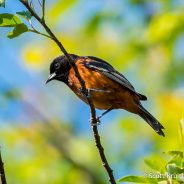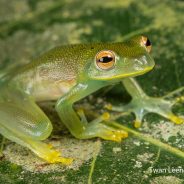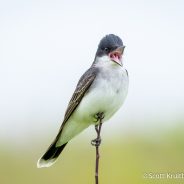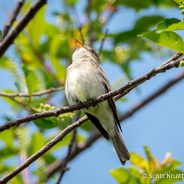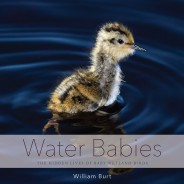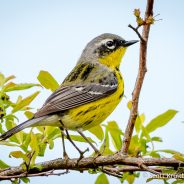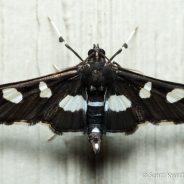I love this time of year. After the exuberance of summer and the vibrant colors of fall, I’m thankful for the days growing shorter. The nights longer. Temperatures falling. Silhouettes of bare branches against a leaden sky promising snow. All of nature winding down. Encouraging quiet. Reflection. Introspection. [more]
Orchard Oriole
This adult male Orchard Oriole finally gave me a decent couple of poses on a recent morning! My guy was foraging, singing, and defending his territory against various avian intruders when he paused to let me shoot him for a few seconds. His chestnut-like tones look fantastic against the green leaves and blue sky. Someday I want to get a photo of an Orchard Oriole and a Baltimore Oriole for a better visual comparison of their sizes. Orchards are noticeably smaller than their cousins, just a bit larger than our vireos and warblers. It is hard...
read moreKilldeer
I finally got around to editing these photos of a Killdeer (Charadrius vociferus) taken during the Noble Proctor BioBlitz Challenge last month. The bird appeared in the first photo like any other – no big deal. Oh no, this bird is “injured”! Not so much. This is a distraction display, feigning injury, in order to draw our group away from the area and protect a nest or young hatchlings. The bird makes it look like it has a broken wing and has lost the ability to fly, attempting to tempt mammals like us into running them down...
read moreCocobolo Nature Reserve Monitoring
I’m leaving Saturday for another round of research and monitoring on the endangered Limosa Harlequin Frog (Atelopus limosus) monitoring with Alex Shepack, Michael Roy, and Abel Batista in the wonderful Cocobolo Nature Reserve in Eastern Panama. We’re looking for more clues on the enigmatic behavior of the deadly amphibian chytrid fungus in the area and the mechanisms that allow some local frogs to survive. In addition we’ll be setting up opportunities for student research on the project through the Roger Tory Peterson...
read moreEastern Kingbird
Eastern Kingbirds (Tyrannus tyrannus) take a very long trip to arrive in our fields, grasslands, and farms as they spend their winters in South America. This impressive species is named “Tyrannus tyrannus” for a reason as individuals readily attack nearly any other avian species that is in or around their territory or nest. I found what I presume were two late migrants taking a diurnal break on Friday, and their preoccupation with battling and squawking at one another let me snap a few close photos as these bold birds ignored me....
read moreEastern Wood-Pewee
I recently mentioned that we still have flycatchers coming into the region as spring migration wraps up, and even into early June you may find individuals at migratory stopover sites. One such bird was this Eastern Wood-Pewee (Contopus viren), and he provided far better looks here than most do in the depths of the dark forest or higher up in the canopy. Finding him was easy thanks to that “peeeeaaaweeee” call, and he is belting it out in the second photo. Identifying flycatchers by voice makes life so much easier, especially when...
read moreWater Babies Ending
Water Babies An Exhibition by William Burt March 11 – June 5, 2016 Ending this Sunday! For 40 years, photographer William Burt has chased after the birds few people see: first rails, then bitterns, nightjars, and other skulkers – and now these, elusive creatures of a very different kind: the Water Babies. They are the subjects of his new book, and a new exhibition to be featured at RTPI. As in Burt’s earlier exhibitions, Water Babies showcases a selection of the best works featured in the book of the same title. It features 40...
read moreYellow-throated Vireo
The Yellow-throated Vireo (Vireo flavifrons) seen here did plenty of singing and foraging for me on a recent spring morning while his mate tended to their new nest. They were located, as always, on the edge of a large forest, and while they love the cuts they do need sizable, unbroken woodlands. If you take a look at them from afar you may wonder why they have such a plumage…but if you look at some of my photos you may not have to ponder that anymore. What a perfect camouflage, especially in the spring! I have no doubt those looks help...
read moreBaltimore Oriole
Those Baltimore Orioles (Icterus galbula) do love to stay high in the canopy of trees, and often enough all you can do is catch a quick glance of orange and black zipping by. If you know their call you probably end up hearing them far more than seeing them. This adult male did give me a minute to snap his shot as he came down to the mid-levels. He and his mate were busy feeding, and I presume they have a nest and eggs already on the way. If you have a pair in your neighborhood and would like an even better viewing opportunity then I suggest...
read moreMagnolia Warbler
This week is the end of May, and the soon to be end of northbound avian migration. You might be lucky enough to still pick up some birds moving north – a late warbler or two, some shorebird stragglers, a tardy thrush, or some of the intentionally slower flycatcher species such as the uncommon Olive-sided Flycatcher that can be heading to breeding grounds in June. I have yet to see one of them this year after missing them last year as well. Before then I had seen one or multiple Olive-sided Flycatchers for five straight years including...
read moreGrape Leaffolder (Desmia funeralis) Moth
Last year I started looking more at the seemingly endless world of moths, a Roger Tory Peterson tradition and passion when he was a small boy in Jamestown. Day and night, cloudy or clear, cool or hot, forest to shore – there are moths everywhere, and their flight seasons are always changing throughout the spring, summer and fall. I intend to continue to do some mothing this year when I can find a little time here or there. On Friday evening I found several new (to me) and unique moths including this Grape Leaffolder (Desmia funeralis)...
read more



